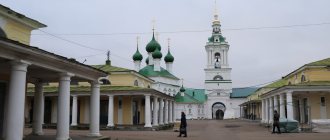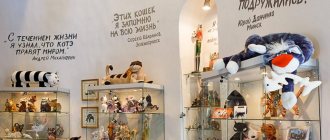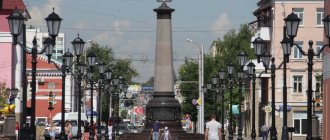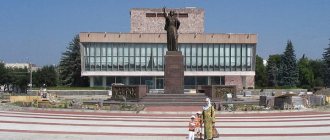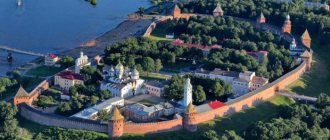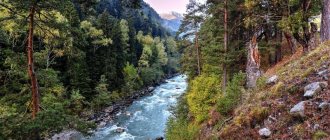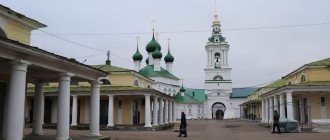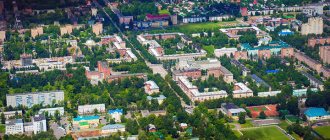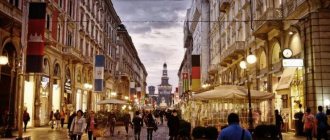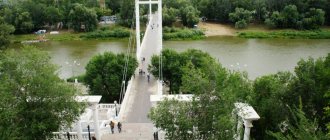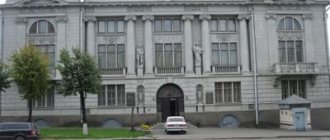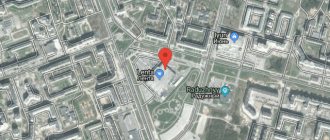In the Kostroma region there are more than two and a half thousand architectural, historical and religious monuments. The writer Nikolai Ostrovsky and Ivan Susanin lived here.
Currently, various festivals are held in the region - fireworks “Silver Boat”, chess, in honor of the Snow Maiden’s birthday, “Flower Ball”.
The activities of craftsmen who make linen clothing, pottery and birch bark dishes, and jewelry are well developed.
For ease of route planning, we have marked all mentioned cities and attractions on the map of the region:
Churches and monasteries
Ipatiev Monastery
The monastery is located at the confluence of the Kostroma and Volga rivers, surrounded by mighty fortress walls.
Once he occupied a strategic position, he was patronized by the Romanovs and the Godunov boyars. It so happened that the Ipatiev Monastery became the refuge of the first Tsar of Russia, where young Mikhail Romanov was elevated to the throne.
It is not known for certain when the monastery was founded. Chronicles mention it from the middle of the 15th century, but there is every reason to believe that the first wooden buildings were here already in the 13th century.
The main building of the monastery is the five-domed Trinity Cathedral. Its interior is richly painted with frescoes, and there is also a shrine - the miraculous icon of the Tikhvin Mother of God.
On the territory of the monastery there are the Church Historical and Archaeological Museum and the Museum of the Chambers of the Romanov Boyars.
There is also a museum of wooden architecture. This is an open-air museum, opened in 1958. Then the most valuable remaining wooden buildings - huts, churches and the like - were brought to the center from the entire region. In Kostroma itself, samples of wooden architecture were not preserved due to fires. What they managed to collect, the restorers put it in order, made it into a museum, and now everyone can see how people lived in past centuries.
In 2004, it was solemnly transferred to the Russian Orthodox Church.
Epiphany-Anastasia Monastery
Address: st. Simanovsky, 26Telephone
A pearl of Russian architecture, built in the Russian Baroque style.
This is an active convent, founded in 1426 by Nikita Kostromsky, a student of Sergei of Radonezh. At first, all the buildings were wooden, and only in the middle of the 16th century the first stone Epiphany Cathedral appeared.
In the 17th century, despite the Time of Troubles, buildings continued to be erected in the monastery - residential and utility buildings, churches.
In the middle of the 19th century, there was a severe fire in the city, the monastery was almost dismantled, and only the protests of the townspeople helped it survive.
Church of the Resurrection on Debra
Address: st. Nizhnyaya Debra, 37 Phone
The church is located on an old place of worship - Nizhnyaya Debra. Wooden churches were constantly erected here. But due to frequent fires, they did not last long.
A stone temple was erected here in 1623-1645, and it was one of the first stone buildings in Kostroma - until the mid-18th century it remained almost entirely wooden. At that time, the temple was luxurious and very large - a three-apse, five-domed cathedral. The temple was painted by famous masters of that time - an artel led by V.I. Zapokrovsky.
The money for construction was given by the Kostroma merchant Isakov. According to legend, he bought several barrels of paint in England. One of them contained gold. The God-fearing man considered this an order from above and donated the barrel to the city treasury - to the temple. Since the wooden church had burned down shortly before, it was decided to build a stone one in its place. And Isakov himself went down in the history of the city as a philanthropist.
The church miraculously survived in the 1930s and was returned to the Russian Orthodox Church in June 1946.
Women must have a headscarf and preferably wear a skirt.
Churches, cathedrals and temples
Church of the Epiphany (Krasnoe-on-Volga)
Address: town Krasnoe-on-Volge, st. Nekrasova Phone: +7 (49432) 2-75-76 Website: www.kostromaeparhia.ru Opening hours: Mon-Sat 9:00-18:00 How to get there: from Kostroma along highway 34N-2 to the village of Krasnoe-on-Volge — 39 min., 54 km, by bus — 1 hour 15 min.
The only thing that has been preserved in the temple since its construction in 1592 is the hipped bell tower.
During the restoration work, the iconostasis and paintings on the walls were restored. Previously, there was another church here in honor of Saints Peter and Paul, but in the 30s of the 20th century it was destroyed.
The temple houses icons of the Blessed Virgin Mary and St. Nicholas the Wonderworker.
Makaryev-Unzhensky Monastery
Address: Makaryev, pl. Revolution, 14A Phone: +7 49445 5‑54-00, +7 910 950‑21-77 Website: aghios-makarios.ru Opening hours: Mon-Sun 6:00-18:00 How to get there: from Kostroma along highway R -243 to the city of Makaryev - 2 hours 48 minutes, 188 km, by bus - 3 hours 22 minutes.
The monastery was founded in 1439 and was a male monastery until 2016.
During the restoration, it was possible to restore part of the wall with a gate made in the 17th century. Currently, restorers are trying to recreate the bell tower destroyed in 1938.
There is a spring of St. Macarius on the territory, and on holidays you can venerate his relics.
Church of the Resurrection in Susanino
Address: pos. Susanino, st. Sovetskaya, 33A Phone: 8(49434) 9-15-20, 9-13-36, 9-12-73 Website: https://www.kostromamuseum.ru/ Opening hours: Mon-Sun 9:00–18: 00, Fri - closed Cost: adult - 50 rubles, children - 30 rubles. How to get there: from Kostroma along highway 34N-3, after Zogzino turn left - 1 hour 1 minute, 62 km, by bus - 1 hour 27 minutes.
The artist Savrasov depicted the church building in the painting “The Rooks Have Arrived.” In the former temple there is a museum named after the feat of Ivan Susanin.
The exhibitions are dedicated to the history of the Polish conquest, Ivan’s feat and the last years of the life of the royal family.
The excursion includes a visit to the Romanov family home, as well as a walk to the supposed place of the hero’s death.
In addition, the funds contain collections of Peter’s toys, ceramics and ethnographic objects.
Holy spring "12 keys"
Coordinates: 57.465300 E, 43.903600 N How to get there: from Kostroma along the P-243 highway, turn left before Makaryev - 5 hours 28 minutes, 240 km
There is a legend about the appearance of the source. Previously, there was a monastery on this site, which eventually went underground. Local residents began to see unusual lights and decided to see what it was. When they arrived, they saw twelve keys. It is believed that the water in it can heal.
The keys were decorated with special wooden containers, and benches and gazebos were installed nearby. Most tourists come for the baptism holiday.
If you have not yet chosen where you will live and want to save money when booking, we recommend using the RoomGuru service. Firstly, it contains hotels, apartments and guest houses from many different booking systems, so you won’t miss out on a worthwhile option. Secondly, you can immediately compare prices for one place in different services and book where it is cheaper (this is not always Booking!).
What to see in Kostroma - TOP 5
Among all the interesting things to see in Kostroma, it is certainly worth highlighting several attractions, with a visit to which it is customary to begin getting acquainted with the city. They are his business cards, familiar even to those who have never been here. They are often examined within 1 day.
Fire Tower
Address: st. Simanovsky, 1. Transport stop "Susaninskaya Square".
The true decoration of Susaninskaya Square is the fire tower, which appeared in the city in 1827. A magnificent monument of architectural classicism is rightfully considered one of the calling cards of Kostroma. With its exterior, the building is very reminiscent of an ancient temple, the portico of which is supported by six columns of the Ionic order. The structure is crowned with an extraordinary graceful tower, decorated with rustication. At its top there is an elegant gazebo covered with a dome and a spire. The gazebo is surrounded by a parapet made of cast iron. The facades of the building are richly decorated with rosettes and stucco, and on the pediment of the portico there is a bas-relief depicting a double-headed eagle.
Ostrovsky's gazebo
Address: st. 1st of May. Transport stop "Gornaya Street".
A magnificent rotunda, built on the spot where, according to the recollections of contemporaries, the classic of Russian literature and drama A.N. loved to stroll. Ostrovsky, appeared in Kostroma in 1956, quickly becoming one of the symbols of the city. The elegant structure, the dome of which is supported by slender columns, is a magnificent example of small architectural forms that adorned the estates of wealthy townspeople in the 18th-19th centuries. While creating one of his best films, “Cruel Romance,” based on A. Ostrovsky’s wonderful play “Dowry,” director N. Mikhalkov filmed several episodes against the backdrop of the rotunda.
Monument to Ivan Susanin
Address: st. Transport stop "Susaninskaya Square".
The Kostroma land gave the Fatherland many heroes, among whom an honorable place is occupied by the village elder Ivan Susanin, who saved Emperor Mikhail Romanov from the Polish-Lithuanian knights in the Time of Troubles. The peasant's name has become a household name, and his feat is considered a symbol of self-sacrifice in the name of the Motherland. The monument to the hero was first erected in the city back in 1851, but after the revolution it was demolished by the Bolsheviks for ideological reasons. However, in 1967, justice triumphed. The sculpture of Ivan Susanin took its place on a massive pedestal in the center of the square of the same name.
Susaninskaya Square
Coordinates on the map: 57.767891, 40.926851.
The geographical and social center of the city of Kostroma and the destination of meetings is Susaninskaya Square. It hosts all the most important citywide events, open-air exhibitions and exciting fairs are held here, and the main New Year tree in the city is located here during the New Year and the Nativity of Christ. And on the square you can take a photo against the backdrop of several memorial signs and places, including the Memorial Nail, the Hero Dog, the Dove, the Snow Maiden and the Ship. Botnikovsky Square near the City Hall is also nearby.
Monument to Yuri Dolgoruky
Address: st. Soviet. Transport stop "Voskresenskaya Square".
For its 850th anniversary, which Kostroma celebrated in 2003, local patrons gave it a new attraction. Then a monument to the founder of the ancient city, Yuri Dolgoruky, was solemnly unveiled on Voskresenskaya Square. Under the foundation stone of the monument they placed soil taken from the grave of the Grand Duke. According to eyewitnesses, after some time the cornerstone began to stream myrrh. The height of the monument is 4.5 m. Yuri Dolgoruky, dressed in a royal dress and Monomakh’s hat, sits on a carved bench. With one hand he leans on the sword, and with the other he points to the place where the hail should be laid. The townspeople have a belief that when you make a wish, you just need to rub the prince’s outstretched hand for it to come true.
Kostroma Museum of Folk Crafts “Petrovskaya Toy”
In the Kostroma Museum you will be introduced to folk crafts and traditional Peter's clay toys. The museum contains about 1000 clay exhibits, works by famous folk artists Mikhail Shmarov, Svetlana Pimanova (Kostroma), as well as original products by masters from different regions of Russia.
Any museum visitor can see how, within 10 minutes, without a special tool, an Ocarina (whistle) is created from a piece of clay. If you wish, you can master pottery or clay modeling under the supervision of masters. It is worth adding that such events make children very happy.
Where to go with children in Kostroma
The hospitable city has prepared a wonderful entertainment program for children. You can take kids to the puppet theater, and teenagers will certainly be interested in the attractions installed in the parks. However, this is available in almost every city, but such wonderful museums as in Kostroma cannot be found anywhere else.
Museum "Forest-Wizard"
This wonderful museum invites you to visit the world of a fairy tale, where adults are not prohibited from entering. Its exhibition is located in the halls where the surroundings of a village hut are recreated. One part of the exhibition is dedicated to the mysterious inhabitants of Russian forests - Baba Yaga, the goblin, and the merman. In the “Nature's Pantry” section, visitors learn about the healing properties of forest plants. A separate room is dedicated to masterpieces made by skilled Kostroma blacksmiths. The children are invited to take part in a master class on weaving trinkets from birch bark or willow twigs.
Museum "Kostromskaya Sloboda"
A visit to the most interesting museum “Kostromskaya Sloboda” will leave a lot of unforgettable impressions for the child and parents. It occupies a picturesque cape at the confluence of the Volga and Kostroma rivers. Here, against the backdrop of picturesque nature, are located monuments of ancient Russian architecture, brought from all over the region in the middle of the last century. At that time, many villages fell into the flood zone during the construction of the Volga Reservoir. The ancient buildings were carefully dismantled and then restored on the museum grounds.
Arriving at this wonderful place, it’s easy to be transported back several centuries. Here you can see a unique wooden church, built in 1552, several other small churches, huts covered with openwork carved lace, barns, baths resembling huts on chicken legs. The museum staff has prepared a special program for children. The children will be told about the secrets of the wonderful Russian stove and invited to take part in the quest “Searching for Koshchei’s Treasure.”
Museum "Peter's Toy"
- Opening hours: daily, from 9:00 to 18:00.
- Ticket price: adult 70 rubles, children 30 rubles, children under 5 years old can travel for free.
- Telephone.
- Address: st. May 1, 24. Transport stop “Station of Young Technicians”.
Authentic toys made by craftsmen from the village of Petrovskoye are known far beyond the Kostroma region. At first, local potters made whistles for children from leftover clay for fun, but then it turned into a profitable trade. The peculiarity of Peter the Great's toy is that it is not painted, but decorated with a characteristic ornament. Whistles are striking in their variety of shapes. They were made in the form of wild and domestic animals, human figures, and household items. The collection, consisting of 1000 exhibits, also includes Kargopol, Skopinsky, Filimonovsky, and Dymkovo clay toys. Particularly popular among children are master classes in which they fashion souvenirs from clay with their own hands.
Museum "Fairytale Land of the Snow Maiden"
- Address: Molochnaya Gora street, 7.
- Phone: +7-4942-37-17-82.
- Ticket prices: from 50 to 70 rubles.
- Working hours: from 9:00 to 17:00, weekends – Saturday and Sunday.
Next to the Small Flour Rows and the building of the Department of Education, almost on the banks of the notorious Volga River, this small but very interesting museum is located. The building where it is located does not stand out except for the white facade. But there’s a lot of interesting stuff inside, despite the fact that the funding for the Snow Maiden’s Fairytale Land is called cheap in reviews. On display are various outfits of the main New Year's lady, unique exhibitions in the form of dolls and reels, fabulous scarves and hats, as well as a lot of other interesting things.
It’s easy to have a wonderful time in Kostroma, traveling alone or with the whole family. Having been here, you can feel all the charm of the Russian outback, stock up on a great mood and bright emotions.
Kostroma souvenirs
Traditional souvenirs that have glorified Kostroma craftsmen far beyond the region are linen and jewelry. Local linen products - tablecloths, towels and clothing - are very popular. They are strong, beautiful and durable. And all because the technology of cultivating and processing flax has been perfected by the inhabitants of the region for centuries. Similar souvenirs are sold at fairs and in Fabric stores.
Cathedral of the Nativity of the Blessed Virgin Mary in the city of Soligalich
Kostroma jewelry products are also famous throughout Russia. After all, there have always been from three to six specialized factories in the region. The Kostroma Jewelry Factory has been operating in the regional capital since 1939 and produces the most modern jewelry products from gold, platinum and precious stones. Moreover, at affordable prices!
Another popular folk craft of Kostroma residents is birch bark weaving. Its secrets are passed down from generation to generation. As a souvenir of your visit to Kostroma lands, you can buy various birch bark crafts: hair clips, beautiful patterned boxes and caskets, photo frames and bracelets.
Cathedral of the Transfiguration in Sudislavl
And lovers of delicious souvenirs will certainly not remain indifferent to the local dairy cheeses. It is not for nothing that Kostroma cheese factories are considered one of the best in the country. Such delicious souvenirs can be bought in grocery stores and markets. And in the summer and early autumn - at the traditional Kostroma fair “Cheese Exchange”, held in the center of the regional capital.
| ← RUSSIA | EUROPE → |
Ipatiev Monastery and Museum
Lovers of deep antiquity have something to see in Kostroma. Sights from the period of formation of the Romanov dynasty are carefully preserved in the Ipatiev Monastery. Trinity Cathedral is the basis of the collection of the Church Historical and Architectural Museum, created in 2004. The stands contain unique items - monumental paintings, ancient icons, and applied art objects.
The temple itself is a living monument of ancient Slavic architecture; here the first monarch from the Romanov dynasty received his consecration as king. The Ipatiev Monastery is active, the museum exhibition is located only in the Holy Trinity Cathedral. The interior of the five-domed church is painted with frescoes; the exhibition includes icons in precious frames, reliquaries with relics, and church utensils made of gold and silver. Pilgrims are attracted by the miraculous icon of Our Lady of Tikhvin.
The year of foundation of the monastery is considered to be the 15th century, but many researchers believe that wooden monastery buildings already existed in the 13th century. The monastery enjoyed the privileges of almost all reigning dynasties; in our time, the presidents of the Russian Federation also consider it necessary to visit the monastery. Address of the museum and monastery: Prosveshcheniya Street, building 1.
Museums and residences
The city administration is making a lot of efforts to develop tourism in Kostroma. In winter, it is not always comfortable to see the sights while wandering along the street. But there are several places where any visitor will feel the charm of the city:
- The residence of the Snow Maiden (Lagernaya str., building 38) is a large two-story tower of the granddaughter of Father Frost. Children will be interested in puppet shows and an exhibition of children's works made using traditional folk craft techniques. The ice room is worthy of special delight, where there are drinks for children and adults, and they need to be drunk from ice glasses.
- Museum of Flax and Birch Bark (Tereshkova St., building 38). An interactive exhibition introduces the history of flax spinning and the creation of birch bark products, and master classes are held. The exhibition includes historical peasant costumes made from flax and a collection of items made from birch bark. Visitors can purchase souvenirs and gifts.
- Museum “Petrovskaya Toy” (1 May Street, building 24). The small museum includes two halls - “Peter’s Toys” and “Folk Crafts”. The stands display clay whistles (ocarinas) - this is the first wind instrument in Rus', as well as Dymkovo, Kargopol, and Skopin clay toys. In front of visitors, the master creates pottery and toys using a pottery wheel.
A large number of Kostroma tourist routes pass through the urban environment
Sights worthy of attention are located in the historical center; for one day it will be enough to pay attention to Susaninskaya Square, where the architectural ensemble of buildings has been preserved and perfectly restored, each of which has its own history. In addition, many of them today house museums where you can learn the history of the city, a specific place and take many photos as a souvenir.
Natural attractions
Reserve "Kologrivinsky Forest"
Most of the reserve is occupied by relict spruce forests. The age of some trees is approximately 350-450 years, and the height is up to 45 meters. In spring, ducks, geese and geese arrive. Bears, wolverines, lynxes, and wolves live on the territory.
The administration organizes a tour to the Princes of the Desert, where the monastery used to be located. There is also a holy spring of three springs here.
The open-air museum will tell you about the features of the forest and show you Red Book plants. An excursion to the logging village of Londushka, where the repressed worked, is also possible.
Galich Lake
Address: Galich
The lake is small in size, although it is considered the largest in the region - 76.6 sq.m., and the depth is generally about two meters. People fish and hunt here. Organized boat trips and yacht rentals,
According to legend, a treasure with jewelry is buried at its bottom, but it can only be retrieved by killing the first-born son.
The reservoir gradually becomes shallow, and the bottom becomes muddy. Most of the fish population has been fished out and will take years to recover.
Swimming in the lake is prohibited due to contamination from industrial waste.
Susaninsky swamp
The swamp occupies an ancient glacial basin. Some plants, for example, orchids and Siberian buzulnik, are listed in the Red Book of Russia.
For tourists, there are special trails along which you can get to the supposed place of death of Ivan Susanin, which is called Red Pine. Nearby, on a boulder there is an inscription with the name of the man who saved Mikhail Romanov from the Poles.
Natural monuments of the Kostroma region
Church of the Resurrection in the village of Susanino. Shown in the painting “The Rooks Have Arrived” by Alexey Savrasov.
The lands of the Kostroma region extend over an area of just over 60 thousand square meters. km. and occupy a moraine-hilly, sometimes swampy, plain. 62% of the entire territory is covered with forests. These unique forests are included in the UNESCO World Heritage List and are among the 100 most valuable forests in Europe.
In addition, 53 reserves have been created in the region and 18 unique natural monuments are protected.
A notable natural attraction - the territory where the European dark coniferous taiga is protected - is the large biosphere reserve "Kologrivsky Forest". Interestingly, some of the local protected forest lands have never been exposed to human activity and have not been affected by fires, mainly due to the distance from human habitation. Therefore, individual trees reach an age of 350-400 years and a height of 40-45 m. Such relict spruce forests do not exist anywhere else in the European part of Russia.
Church of the Epiphany in Krasnoe-on-Volga
In the Sumarokovsky Nature Reserve (Krasnoselsky District), tourists love to visit the elk farm. Here, on an area of 200 hectares, work has been underway on the domestication of elk since 1963 - a unique scientific experiment, the only one in the world.
The farm is open to guests all year round. And there you can not only see moose and take pictures with the animals, but also try nutritious moose milk.
Kostroma Drama Theater and Theater Costume Museum
Kostroma is famous not only for its historical sights, but also for its theaters. The largest theater in the city is the theater named after A.N. Ostrovsky. Kostroma is the birthplace of such people as A.N. Ostrovsky, F. Volkov and the world-famous Russian theater director, Stanislavsky Konstantin Sergeevich.
The Kostroma Drama Theater was founded in 1808. At first it was located in a small building, but later local merchants built a new building on Pavlovsky Street. The theater burned down, but the townspeople restored it without changing its original architectural appearance. It received its name, in honor of Ostrovsky, in 1923. Today the theater's repertoire includes golden classics of Russian and world drama, productions based on stories by writers George Patrick, William Shakespeare and Bernard Shaw. But the theater is most popular when there are productions based on Ostrovsky’s plays.
In addition, on the territory of the theater there is a Museum of Theatrical Costume. Its exhibitions feature costume collections dating back to 1920. The costumes were created in a local workshop, which still exists today, and is located in the theater building.
Merchant and noble estates of the Kostroma region
Museum-reserve of A. N. Ostrovsky “Schelykovo”
In the Kostroma region, several ancient noble estates have been preserved, built mainly in the 19th century. The most popular among tourists was the Shchelykovo estate, which currently has the status of a memorial and natural museum-reserve.
It is located 120 km from the regional capital and is connected with the life of the Russian writer A.N. Ostrovsky, as well as famous actors of the Maly Theater. Shchelykovo recreates the atmosphere of life of the Russian nobility in the 19th century.
The restoration of the estate complex in the village of Dolmatovo, which belonged to A.P., was recently completed. Ermolov. And in Kostroma itself you can see two-story manor houses that were owned by the Arzhenikovs, Ashastins, Zotovs, Gornyakovskaya, A.N. Ponizovsky, A.P. Durygin and A. Sovin.
The largest cities in the Kostroma region
List of the largest cities in the region by population.
Kostroma
An ancient city founded on the Volga by order of Yuri Dolgoruky in 1152. The city has preserved ancient buildings. The center is Susaninskaya Square with a monument to the famous Russian peasant, around which there are many ancient buildings, unique galleries of shopping arcades, and carved huts. In the city you can visit museums of folk arts and crafts, temples and monasteries.
Population – 277 thousand people.
Buoy
A small well-kept town 100 km from Kostroma. The history begins in the 16th century, with the construction of a fortress to protect it from Mongol-Tatar raids. The buildings of this fortress have survived to this day. The architecture is represented by buildings from different eras: Orthodox churches and monasteries, merchant estates. The area around the city is very picturesque.
Population – 24 thousand people.
Sharya
An ancient town in the northeast of the region, 300 km from Kostroma. The city is named after the Sharinka River, a tributary of the Vetluga. It developed from the beginning of the 20th century thanks to the construction of the railway. The city produces its own mineral water. In the Sharya district there is a spring of St. Barnabas, famous among Orthodox Christians throughout the country.
Population – 24 thousand people.
Nerekhta
The city is located 46 km from Kostroma, on the Solonitsa River. The first mentions date back to the 13th century. Included among the cities of the “Small Golden Ring”. The atmosphere of an ancient noble estate still reigns here. White stone churches, shopping mall buildings - all this is still in operation. The Museum of Jewelry Art and the Horse Yard Museum are open. In the surrounding area there is a picturesque 17th-century monastery.
Population – 21 thousand people.
Galich
The city is included in the official list of “historical settlements” in Russia. Founded in the 12th century, ancient settlements from which the history of the city began have been preserved in the surrounding area. Galich Lake is a unique natural object with a length of 17 km. The city has a large number of historical buildings, including Orthodox churches of the 17th-19th centuries.
Population – 17 thousand inhabitants.
Volgorechensk
Founded as a workers' settlement at the beginning of the 20th century for the construction of the Kostroma State District Power Plant. It is located 40 km from the regional center, in a picturesque natural area on the right bank of the Volga. In the immediate vicinity of the city there is the Church of the Epiphany of the 16th century, the Church of Elijah the Prophet of the 19th century, and the ancient merchant estate of Bogdanovo-Vitovo.
Population – 17 thousand people.
Manturovo
The city is located on a tributary of the Volga - the Unzha River, a settlement in this place has been known since the 16th century as lands that belonged to the Romanov dynasty. There is a unique recreation area “Sosnovy Bor” - a place for tourist excursions, ski trips and competitions. There are many architectural monuments in the surrounding area: Fonvizina's estate, merchant houses, ancient churches. In the village of Usolye there are healing mineral springs.
Population – 16 thousand inhabitants.
Not me
The city is located on the banks of the river of the same name, 237 km from Kostroma. Founded at the beginning of the 20th century as a village at a railway station. The city has a local history museum and a large city park with access to the river. Several unique churches of the 18th-19th centuries have been preserved in the surrounding area. In the floodplain of the river there are Kaurovsky lakes in the environmental protection zone.
Population – 9 thousand people.
Makariev
The city is located on the Unzha River, it arose in the 14th century, originally there was a settlement at the monastery. The Makarievo-Unzhensky monastery complex has survived to this day. The architectural plan of the city is in many ways similar to Kostroma; many objects from the 18th-19th centuries have been preserved. The city has a garden, the centerpiece of which is a 200-year-old pine tree, the “Tree of Love.”
Population – 6 thousand people.
Soligalich
A small, clean ancient city located on both sides of the Kostroma River. Massive historical buildings include a large number of architectural monuments: churches and monasteries, shopping malls. The city is located on the site of salt mineral springs; a resort with healing mud and mineral water has been operating here since the 19th century.
Population – 6 thousand people.
Cities and villages
Kostroma
The city is included in the Golden Ring of Russia, thanks to the large number of ancient churches. Kostroma became the “cradle of the Romanov dynasty” when Mikhail Romanov was crowned king in the Ipatiev Monastery in the 17th century.
Over the years, N. Ostrovsky, N. Nekrasov, and B. Kustodiev lived and worked here. The films “Cruel Romance” (the gazebo filmed in one of the frames is located on the embankment), “Isaev”, “The Barber of Siberia”, “Kotovsky”, “The Snow Maiden” were filmed in the city.
- Museum complex of the Snow Maiden. Theatrical performances and excursions are held here, and thematic performances are held during the New Year holidays.
- Museum of Wooden Architecture. It displays products from local craftsmen dating back to the 17th century.
- In the “Wonder Forest” museum they talk about natural resources, fairy-tale characters and conduct master classes. The exhibition "Berendey's Tower" is dedicated to the ancient people - the Berendeys. The exhibits include statues of Slavic deities - Mokosh, Veles, Perun and others, ancient toys, ancient tools and peasant household items. The exhibition complex itself is built in the form of chambers decorated with carved figures.
- The city Museum of Unique Toys has a large collection of dolls from different countries - France, Thailand, Java, Cyprus. Some specimens move and sing. There are also ritual dolls made to attract good luck, love, and wealth.
- Susaninskaya Square is popularly called “frying pan” for its seven wide sidewalks, reminiscent of the handles of a kitchen utensil. There are monuments to Ivan Susanin and the first Russian Tsar Mikhail Romanov.
Everything a tourist needs to know about Kostroma
Galich
The city is located 120 kilometers from Kostroma on the shores of Lake Galich. During the time of tsarist rule, it was one of the trading centers of the Moscow principality, despite the constant raids of the Tatar-Mongols.
Catherine II, Alexander I, and Prince Stolypin came here.
At the end of the 20th century, traces of ancient settlements from the 12th century were found on Balchug Hill. On Shemyakinskaya Mountain there is a second settlement, on which an observation deck is equipped. From there you can see the defensive ditches of the Great Patriotic War. Nearby there is a monument to those killed in the Time of Troubles.
- Every year the city hosts the short film festival “Families of Russia” and the Day of Remembrance of the writer Alexei Pisemsky. There is a memorial tablet installed on the house where he lived.
- The Museum of Local Lore, opened in 1922, contains objects from the 17th to 20th centuries, including dishes, wood and clay products, paintings and handicrafts.
- Paisiev Monastery. Built in the 14th century, only one of the five chapters of the cathedral has survived; it is now being restored.
- Shopping arcades. The buildings with arched vaults were built in 1825 and continue to operate today.
Nerekhta
The city was first mentioned in the chronicles in 1214, when the eldest sons of Vsevolod the Big Nest fought for it. After the Mongol Tatar attack in the 13th century, a student of Sergius of Radonezh came here and founded a monastery that is still in operation.
- The Vladimir Church is the oldest building in the city, built at the expense of Peter I. It houses the icon of the Mother of God, copied from the Vladimir Church.
- The Trinity-Sypanov Convent contains the relics of St. Pachomius, a disciple of Sergius of Radonezh. Nearby there is a source of holy water.
- The Horse Yard Museum has more than 500 items dedicated to horse breeding. In the Museum of Jewelry Art, in addition to samples from the 16th-19th centuries, there are modern creations. It also hosts interactive exhibitions and master classes.
- The house of the merchant Khvorin is called the “sock” for its special shape. According to legend, Emperor Paul I rested here.
- Every year in May the feast of St. Pachomius takes place, on this day the holy spring is visited and an interregional folk music festival is held.
Buoy
The city was built by order of Tsar Ivan the Terrible and was intended for defense against raids. Then they built a fortress and an earthen rampart, which became unnecessary after the capture of Kazan. Their remains still remain, and part of the palisade and watchtowers have been restored. A rotunda with an observation deck was built nearby in the 17th century. Access to it is open.
- At the railway station there is the Church of St. Nicholas the Wonderworker - one of the few in the country that opens directly onto the platform.
- In the city center there is a park of wooden sculptures made by local craftsmen. All of them are made in a fairy-tale theme and seem to grow from the ground.
- In the suburbs, archaeologists discovered a site of people from Neolithic times; parts of tools and jewelry are found here.
- In the People's Museum of the History of Railway Transport you can see models of old steam locomotives and the monumental steam locomotive L-2218 built in 1953, as well as get acquainted with the operation of trains.
- Museum of Local Lore named after. T. V. Olkhovik. Most of the exhibits are dedicated to the Great Patriotic War: medals, weapons that took part in battles, photographs and letters from soldiers from the front. Part of the exhibition represents the animal world of this area - there are stuffed owls, foxes, and raccoons.
Holy spring "12 keys"
In the forest where the river Cherny Lukh is located, there is a holy spring. There is a legend that a long time ago there was a monastery there, which one day went underground, and after some time glowing lights began to appear there. The people were interested in this miracle of nature and began to come there and pray. There 12 streams appeared, which personified 12 saints living in that monastery.
Today tourists visit this place with pleasure, especially since a gangway with railings has been built there for the convenience of residents and visitors who decide to visit this source. Even in the heat, the water there remains cold, but those who dare to swim in the holy spring will be healthy and find happiness. In winter the source does not freeze.
General information about the Kostroma region
The Kostroma region occupies an area of more than 60 thousand square meters.
km and is the 47th largest subject of the Russian Federation by area. The structure includes 24 districts and 12 cities: Bui, Volgorechensk, Galich, Kologriv, Makaryev, Manturovo, Nerekhta, Neya, Soligalich, Chukhloma, Sharya. Administrative center: Kostroma. Population: 654,390 people. Nationalities: more than 114 live in the region nationalities, 97% of which are Russian. Borders: Vologda, Ivanovo, Nizhny Novgorod, Yaroslavl, Kirov regions. Visiting cards: Ipatiev Monastery, Susanino, Sumarokovskaya moose farm, How to get there Kostroma is a major transport hub, so getting to your destination will not be a problem . You can do this in one of the following ways: By bus The most common is bus service. After all, Kostroma is connected by federal highways M8 and P600 with Yaroslavl, Ivanovo and Vladimir. That is why bus trips are most often made from these cities. There are 6 flights a day in the Moscow-Kostroma direction every day. The journey will take about 8 hours. Ticket price starts from 700 rubles. There are also daily routes from Moscow through Yaroslavl. Travel time is 5 hours. Ticket price from 550 rubles. Reservations by phone: 8 (964) 509-49-95. From Yaroslavl to the final stop the trip will take about 2 hours, and from Nizhny Novgorod - about 9 hours. By rail Kostroma railway station, Shirokova Square, 2, 49 -02-25 By car By car you need to move along the Yaroslavl highway and, before reaching Yaroslavl, turn right at the sign. The distance from Moscow to Kostroma by road is 345 km: MKAD - 95 km, then along the M8 highway through Korolev, Pereslavl-Zalessky, Rostov , Yaroslavl. From the last city to the end point, continue along highway A 113. By plane Those traveling by air, 6 km from the city, will be met at Sokerkino Airport (Kostromskaya St., 120). Book tickets by phone. By water transport Passenger ships depart from Yaroslavl, Plyos and Nizhny Novgorod. Kostroma River Port - Kooperatsii Street, 22, tel.: 8(4942)31-39-12,31-20-00 Excursion flights are organized on Fridays, Saturdays, Sundays at 13-00, 14-00, 21-00. Tickets are sold on the ship.
There is a well-established bus service between the cities of the Kostroma region.
Square or “frying pan”?
For an organized tourist, sightseeing in Kostroma begins from Susaninskaya Square. From here, guides begin all routes to historical and simply interesting places. The square is considered the hallmark of the city. In the 19th century, it was paved, flower beds were laid out, and monuments to the famous countryman Ivan Susanin and the Russian Tsar were erected. A wrought-iron fence was installed around the vast park, and linden and fir trees were planted.
After the revolution, priorities changed, the monuments were demolished, and the square was named in honor of the revolution. At the end of the 20th century, with a revision of views on history, the monument to Susanin was reconstructed and reinstalled in the park. Now Susanin is dressed in a long fur coat and holds a staff in his hands. The matter has not yet reached the figure of the king, but it is quite possible that his monument will find a second life. 7 streets radiate from Susanin Square, for this reason it is popularly called the “frying pan” - any of the streets, with a certain amount of imagination, can become the “handle” of kitchen utensils.
One of the local legends is associated with the shape of the residential development of the city and the square. It says that when Tsarina Catherine was reviewing and preparing the city plan for approval, she accidentally dropped an open fan on the map. Having examined the resulting form, she commanded: “Build it like this!” Ivan Susanin Square and the historical buildings around it are a worthy route for sightseeing in Kostroma in one day. Next to it there are ancient shopping arcades, public places, Gostiny Dvor and several other architectural monuments.
What to do in the Kostroma region
No matter how many days you have to spend here (just a weekend or a full vacation), you are unlikely to get bored.
The Kostroma region is a large region, rich in both brightly promoted attractions and untrodden forests, which became famous in the time of Ivan Susanin.
Here you can:
- Get acquainted with architectural and historical monuments, numerous temples. There are more than 2.5 thousand such objects here. Most of them are not in the regional center, but in its environs.
- See and taste local industrial products. First of all, these are tasty and high-quality cheeses that true gourmets will appreciate. The heart of any fashionista will tremble at the jewelry and linen products produced by local factories. Shopping may take more than 1 day.
- Go on pilgrimage trips, tours for families with children from Kostroma. They are organized by local travel companies.
This is not a complete list of what you can do in this amazing place.
Historical places
Tower in Pogorelovo
The house was built in 1903 by the rich fisherman Polyashov.
In the 90s, residents left the village; the artist Anatoly Zhigalov, who now lives there and is the only resident, saved the towers from destruction. The outside of the house is covered with carved figures, and inside all the walls are painted. Old dishes and furniture are also stored in the mansion.
Denisovo Estate
Address: pos. DenisovoHow to get there: along the Kostroma - Bolshaya Sandogora highway to the village. Denisovo - 22 min., 14 km, by bus - 48 min.
The building is an architectural monument of the 19th century. It was erected in 1846, at the same time a garden with a pond was built nearby.
The interior decoration and paintings on the walls have not been preserved - until 2008 there was a boarding school here. The building is now up for sale and requires serious restoration.
It is not recommended to go inside it due to the threat of a collapse.
Dolmatovo Estate
Address: s. DolmatovoHow to get there: from Kostroma along the P-243 highway, in front of the Birch Grove, turn right - 1 hour 11 minutes, 42 km; by bus - 1 hour 12 minutes.
According to archaeologists, people lived on the site of the estate back in the 12th century. During restoration work in 2011, tiles from the 16th century, the first coat of arms of the estate and several coins from the 17th century were found.
Of all the buildings, the master's house, stables and servants' house remained intact. The surrounding park with a pond is overgrown, but there is a well-maintained spring on the shore next to the house.
Shchelykovo
The village is a nature reserve with several cultural sites. Here is the estate of Nikolai Ostrovsky, which was turned into a museum and everything was preserved as during the writer’s life.
The Literary and Theater Museum has only two exhibitions - “Ostrovsky’s Theater” with personal belongings and “The Fairytale World of the Snow Maiden”, which tells the story of the creation of the work.
St. Nicholas Church is located two kilometers from the estate. According to legend, it was ordered to be built by F. Kutuzov, who was caught in a storm on the Aegean Sea and promised to build a stone temple for his salvation. Nearby are the graves of members of the Ostrovsky family.
The Blue House was built according to the design of Maria, the writer’s daughter. Nowadays there is a reading room and a library here.
Nearby is the house-museum of woodcarver Ivan Sobolev. It was he who made the furniture for the writer’s house.
Sledovo Estate
The estate is a biological museum, there is a large garden with a lake, and a petting zoo. The terrarium is home to catfish, piranhas and lizards. In addition, ostriches, rabbits, chipmunks, raccoons and owls live here.
Workers also give tours of the estate and talk about its history.
Every year in June the Waltz of the Flowers festival is celebrated.
Parks, entertainment and more
Lavrovskaya factory Moroz-Master
Address: pos. Lavrovo, st. Pobeda, 1B Phone: +7 4942 30‑05-30 Website: terem7.ru Opening hours: Mon-Fri 9:00-17:00 Cost: excursion - 150 rubles, master class - 400 rubles. How to get there: from Kostroma along highway 34N-1, turn left before Nerekhta - 55 minutes, 49 km, by bus - 1 hour 14 minutes.
At the factory, toys and dishes are made and painted by hand. Excursions and holidays are held here.
During the excursions they talk about the history of toys; there is a separate exhibition “Craft hut of the matryoshka craft”. The factory has a collection of musical instruments, including lutes, harps, spoons - you can play them. A separate exhibition is dedicated to patchwork dolls and their history. During the holidays they talk about their appearance and celebration traditions.
Master classes are conducted on patchwork, artistic painting, decoupage and foil gilding. You can take the souvenirs you made for yourself. Before the New Year, they organize the production of Christmas tree decorations.
Sumarokovskaya elk farm
Address: Sumarokovo village Phone: +7 920 389‑53-44, +7 4942 35‑94-33 Website: loseferma.ru Opening hours: Mon-Sun 10:00-15:00 Cost: adult ticket - 150 rubles. , children under 16 years old, pensioners and disabled people - 100 rubles. How to get there: from Kostroma along highway 32N-1 to the village of Sumarokovo - 52 minutes, 23 km, no buses.
The farm is the only one in the world where moose are milked. Tourists can interact with moose in special plots and in the camp. Animals are allowed to be petted and fed; photographs can only be taken without flash.
They sell special “elk” souvenirs (including antlers) and milk in the summer.
Upon prior request, animals can be purchased and taken home.
The farm is located on the territory of the reserve, which means that independent visits to these places are prohibited.
Foxes, raccoons, wild boars and badgers are also found here.
Park on Nikitskaya
Address: Nikitskaya street, 96B, Kostroma
Park on Nikitskaya is a place that you definitely need to visit if you are planning a trip to Kostroma with your children! A large amusement park where everyone can find entertainment to their liking. In addition to attractions, the park includes a variety of recreation areas, playgrounds and concert venues, cafes and restaurants with a rich children's menu.
During citywide holidays, large-scale celebrations take place here, which are accompanied by performances by artists, creative groups, etc. The park is open for walks daily from 9 am to 11 pm.
Monument to Ivan Susanin
Recommend a place
31
4
The very name of Ivan Susanin is probably known to every person. Everyone remembers how a simple peasant, not sparing his life, led the Polish invaders into a swamp. His feat is used as an example to many. Of course, not everyone can boast of such courage to their Fatherland and their king.
For this, in 1835, Emperor Romanov issued a decree to erect a monument in the center of Kostroma so that others would know and honor the memory of the city’s savior. The author of the monument was V.I. Demut-Malinovsky. He knocked out two figures from the stone - the Tsar and Susanin, standing side by side. But his work was not destined to please the eyes of passers-by for long. During Soviet times, the sculpture was demolished.
The monument to Ivan Susanin was restored almost 50 years later. Sculptor N.A. Lavinsky has already made a monument in the person of one peasant. A park and a pedestrian zone were built around the monument, separated by low curbs.
What to see in Kostroma (main attractions)
Susaninskaya Square
Panorama of Susaninskaya Square in Kostroma
The center of Kostroma is Susaninskaya Square. Here are perhaps the main attractions of Kostroma.
- Perhaps the famous symbol of Kostroma is the Fire Tower. This monument was built in the style of classicism. The building itself was erected on the model of an ancient temple by the talented architect P. I. Fursov. Until the 90s of the last century, the building served as a fire station, later it was transferred to the Kostroma Museum-Reserve, and now there is a Museum of Firefighting. There are regular excursions here, and there are several interesting exhibitions and a diorama.
- Another architectural monument of the nineteenth century on Susaninskaya Square is the Guardhouse. Until the beginning of the twentieth century, the building was used for its intended purpose. That is, it was a place where military personnel were detained for violating discipline. Under Soviet rule, the premises of the Guardhouse were alternately occupied by a museum, then a library and a registry office. Nowadays the military-historical department of the Kostroma Museum-Reserve is located there.
- The most famous monument of the Soviet era is the monument to Ivan Susanin, which was built in 1967. It was in the Kostroma forests that Susanin gave his life for the Tsar.
- On Susaninskaya Square there is a monument to a basset dog with a donation mug - a very kind and lively sculpture. Of course, scratching a dog's nose has become a ritual for good luck.
There are monuments to dogs in other cities. There is a similar monument to a dog with a donation box in Tyumen. For some unknown reason, there are especially many monuments with dogs in Belgorod
Milk Mountain and shopping arcades
Kostroma shopping arcade photo
Immediately behind Susaninskaya Square, Milk Mountain descends to the Volga, on which Torg has been located since ancient times. The shopping arcades, built at the end of the 18th century, are a complex of symmetrically located trading pavilions. A cascade of buildings flows towards Milk Mountain. This is the largest structure of its kind, functioning to this day for its original purpose.
Kostroma center
- In the very center of the city, in house No. 5 on Mira Avenue (starting from Susaninskaya Square) there is a two-story building - the Romanov Museum. It began its work at the end of the nineteenth century. The grand opening took place in the presence of Emperor Nicholas II. Now the exhibition provides an excellent collection of photographs of the royal family and a portrait gallery of the Romanov dynasty.
- An excellent example of the construction of provincial classicism is the building of the Noble Assembly (Prospekt Mira, 7). The unique layout, noble interior, rich decor - all this reflects the traditions and customs of the Kostroma nobility of the 19th century.
- The monument to Lenin in the chapel in honor of the anniversary of the Romanov dynasty is called “St. Ilyich.” Behind the monument is the Kremlin Hill, where the temples of the Kostroma Kremlin, demolished during the Soviet years, stood. Now this is where Central Park is located.
- Another symbol of the city is Ostrovsky's Gazebo. She can be found near the River Station in Central Park.
Ostrovsky's gazebo became famous after the filming of the films “Cruel Romance” and “Dark Eyes”. Filmmakers love Kostroma very much. Such films and TV series as: “The Passion of Chapai”, “Kotovsky”, “Isaev”, “Doctor Zhivago”, “Chinese Service”, “The Barber of Siberia”, “Dust in the Sun” (1978), “Two Captains” were filmed here "(1976), "The Beginning" (1970), "The Snow Maiden" (1968) and many others.
Where to stay in Kostroma
Kostroma is one of the historical cities of the Golden Ring of Russia, and there is a lot of housing to accommodate tourists. You can book one of the central options, which is always convenient, and even more so here, because the bulk of the attractions are located in a compact area near Susaninskaya Square.
Or choose interesting options in the surrounding area: for example, the four-star Grand Hotel and SPA Aristocrat Kostroma with a swimming pool or the eco-hotel Alexandrov Bay on the banks of the Volga.
- Kostroma Hotels
- Hostels for Budget Travelers
- Flats and apartments
A useful benefit when booking accommodation on Booking.com is cashback: Cashback promotion on Tourist. RU
In the Shchelykovo estate Photo: © Eduard Skvortsov
